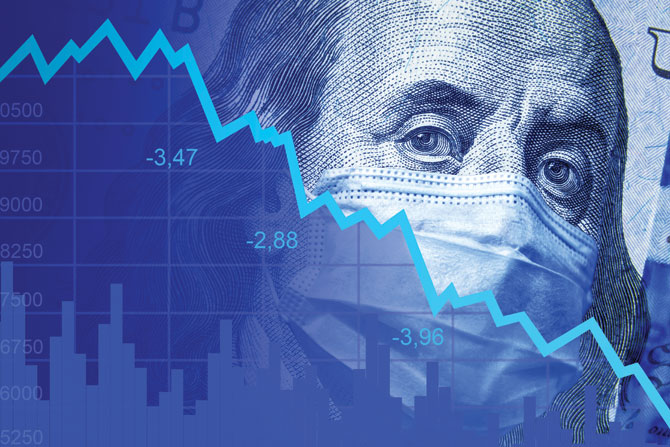When Natalie Gochnour worked with Mike Leavitt at the U.S. Department of Health and Human Services, she learned a thing or two about pandemics several years ago. The most important? They end, and this one will too.
Utah is different from the rest of the nation. Although hard-hit by the pandemic, the state has done better than the country as a whole. Part of the reason why Utah has fared so well is because of the thriving construction industry, leading the way in Utah’s economic recovery.
To put Utah’s situation in context, consider the U.S. economy. Annualized growth during 2019Q4 was 2.4%. That ended with the recession, which took place during 2020Q1 (-4.7%) and 2020Q2 (-32%). Recovery began in April 2020; during Q3, the U.S. economy has recovered 35.3%. The shape of the recovery initially looked like a “V” during the spring months, but it has slowed down considerably since then and now looks like a slow, long, sideways-moving slog.
Natalie compared the length and severity of the current recession, in terms of nonfarm employment, to five other recessions: 1973, 1980, 1990, 2001 and 2007. It is more severe than any of the others, with employment dropping about 14%. Except for the Great Recession that started in 2007, it looks as though recovery may take longer than the other recessions until at least 30 months in. Travel was also down substantially, especially when compared with 2019, and so was the demand for U.S. petroleum products.
How strong is the recovery? In early September 2020, the different regions of the U.S. had recovered but are still, at best, between 80% and 85% of what they were. However, Utah is doing better than the nation as a whole when it comes to unemployment and PPP funds.
How strong is the recovery? In early September 2020, the different regions of the U.S. had recovered but are still, at best, between 80% and 85% of what they were. However, Utah is doing better than the nation as a whole when it comes to unemployment and PPP funds.
Consider unemployment first. Some states see year-over percent employment changes that are as steep as -5.9% to -9.9%, but Utah is at -0.9%. The only state doing better than Utah is Idaho, at -0.5%. The U.S. is now at -6.4%, but that’s where Utah was in April when the U.S. averaged about -13.5%. Who has been hit the hardest? Eastern and red states are the worst. Places that are doing well now, like Utah, were doing well when the nation went into recession, were hurt less initially and got more than their share of PPP help.
However, not all of Utah is doing equally well. Natalie called Utah’s recovery K-shaped. Cache County has unemployment rates of 3.4%. In contrast, San Juan County has unemployment rates as high as 12.8%. Other hard-hit counties include Grand County (12.6%), Uintah (12.2%), Garfield (12.0%) and Duchesne (10.6%).
When it comes to PPP funds for companies with less than 500 employees, Utah is in the top tier. As of Aug. 8, 2020, PPP and cancellations were ≥ 21% of the total annual payroll. For comparison, the nationwide average was 19.4%.
The hardest-hit industries between September 2019 and September 2020 were tourism (-15.7%) and energy (-11.6%). In contrast, construction grew by 6.6%. Single-family construction was the most successful area in construction. It peaked in 2018 at 6,846 units, fell in 2019 to 5,861 units, and started rising again in 2020 to 6,422.
The story is a little different for apartments. Apartments had 3,186 permitted units in 2018, and they were gaining on single-family homes. That growth accelerated in 2019, where the number for single-family homes was 5,861, and the number for apartments was 4,834 — a difference of only 1,027 units. But in 2020, they pulled apart again. The number of new apartments fell to 3,585. The difference between the number of new homes and the number of new apartments increased to 2,837. In other words, the pandemic may have shifted the market away from apartments and toward single-family homes.
Despite all these building projects, Utah’s housing shortage continues to grow and would have still occurred even if there hadn’t been a pandemic. Utah was short 53,100 units in 2019, but the deficit was 15,381 a decade ago.
The construction industry set record levels of new housing construction between January 2020 and July 2020. At the same time, there has been a historic low when it comes to for-sale inventory. For-sale inventory usually rises during the spring and summer and then decreases during the fall and winter. That wasn’t true in 2020. Inventory peaked in May and fell sharply in August. Instead of a list of approximately 9,000 or 10,000+ homes, the number was 5,183. (In August and September 2016, there were about 10,540 homes. These were maximums. The minimums in September 2019 and August 2018, respectively, were 9,836 and 9,347.)
The sold-to-active ratio also showed stress. Its usual pattern is similar to the pattern of for-sale inventory: the ratio of sold to active listings has a maximum value at 50-60% during the spring and summer, then decreases during the fall and winter to about 35-42%. In 2020, the sold-to-active ratio dropped from about 55% in March to about 43% in April. Then it increased sharply to about 98% in July.
The big problem is affordability. Consider housing price appreciation in three categories between August 2019 and August 2020:
- The mortgage rate went down 0.68%.
- Monthly payments went up 3.74%.
- The median sales price went up 13.03%.
When you look at trends, it is essential to distinguish between relatively minor cyclical trends. Cyclical trends are not that big, and they tend to repeat themselves, but structural trends are orders of magnitude larger and can change the world.
What lies ahead? That part isn’t clear. Recovery may take all of 2021, or we might improve by mid 2021. However, Natalie quoted an Indian writer named Arundhati Roy, who won the Booker prize in 1997 for The God of Small Things and said something interesting about pandemics. Arundhati Roy wrote:
Historically, pandemics have forced humans to break with the past and imagine their world anew. This one is no different. It is a portal, a gateway between one world and the next.
When you look at trends, it is essential to distinguish between relatively minor cyclical trends. Cyclical trends are not that big, and they tend to repeat themselves, but structural trends are orders of magnitude larger and can change the world. Natalie listed the following structural trends that she thinks are worth watching:
- A new banking paradigm: During the next couple of years or more, the federal funds rate will stay close to zero. That rate affects the discount rate and the prime rate. Reducing the interest rate to support the economy won’t work anymore. The Federal Reserve has decided to review its monetary policy framework every five years to better respond to the current banking challenges.
- De-globalization, reshoring and shorter supply chains: The pandemic has made it very apparent that long supply chains can be easily broken by disruptions such as pandemics. That’s good news for Utah. As companies shorten supply chains and bring them back to the U.S., Utah is in a great position geographically to benefit from trade conducted more locally.
- The pink-collar recession: The industries that have been hit hardest by COVID-19 are also industries that employ many women. As primary caregivers, many women left the workforce to take care of family members such as young children. Although many men lost their employment as well, more women than men were affected. For example, 3 million women stopped working in April 2020 versus about 2.75 million men. In September 2020, almost 1 million women stopped working, whereas, with men, the number was closer to 250,000 thousand.
- “Zoom town” migration: Remote work was suddenly the only way many companies could continue to stay in business. Since many people were no longer tied to a specific geographic location because of work, they soon became interested in moving closer to family and small towns. The net migration forecast for 2020 in Utah was 22,000. That number represents the difference between the people moving to Utah minus the people moving away from Utah. That is down from 2019 and 2018; the number in 2019 was 24,987, and in 2018 it was 23,200.
- Tech-enabled services: Thanks to internet services and companies like Zoom, which make it possible to hold virtual meetings on a large or small scale, employees have been able to work from home offices like never before.
- The reckoning of commercial real estate: Owners of hotels, restaurants and office buildings have seen a drastic drop in demand for their services. That will affect the commercial building industry.
Vaccines are going to be an essential tool to protect people worldwide from the coronavirus. The first vaccines became available sometime before March 31, 2021. The last may not arrive until April 1, 2022. When researchers decide to start giving vaccines to the general population, it’s expected that medical professionals will distribute 25 million doses in the U.S.







